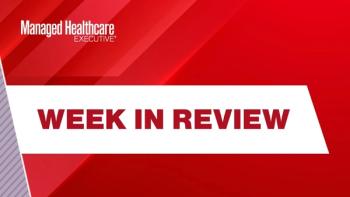
- Managed Healthcare Executive January 2019 Issue
- Volume 29
- Issue 1
Top 4 Challenges Healthcare Executives Face in 2019
Here’s what healthcare organizations will face in the year ahead, and expert advice on how to deal.
Although the ACA is still the law of the land, only bits and pieces of it remain intact as President Trump continued to take actions to dismantle it in 2018. Meanwhile, it’s unclear if and when Congress will resume its quest to implement a new healthcare law.
In light of this, it’s hardly surprising that according to Managed Healthcare Executive’s
Here’s a closer look at the top industry challenges, and what industry experts advise organizations to do to overcome them.
Challenge #1
Complying with policy changes
In MHE’s survey, 32% of respondents listed complying with government regulations and policies as their top concern. In addition to efforts by President Trump and the Republican Congress to get rid of the ACA, this challenge has a lot to do with the fact that some state agencies change rules and requirements yearly, while others issue multiple notices of changes to Medicaid managed care plan operations during the year.
At the federal level, CMS issues more than 400
Related article:
Insurers who offer state or federally regulated lines of business are directly impacted by any change in regulations. “Payers that have hospital systems and integrated healthcare systems in their networks are always affected by any policy changes,” Stevenson says. “While integrated health plans often have access to hospital and physician [
How to deal
C-suite executives need to stay on top of challenges associated with regulation changes, and then rely on experts in those areas to help them navigate those changes in light of their business goals. “Regulatory considerations need to be front and center as business decisions are made,” says Joe Geraci, partner,
Susan Feigin Harris, JD, a partner in the law firm
Joe Paduda, MS, principal,
Challenge #2
Implementing value-based care
Only 40% of respondents to our survey have started initiatives toward value-based care. Furthermore, only 30% said their compensation is value driven.
“Most payers and providers have been operating under a fee-for-service model, so changing to value-based care can be intimidating, complicated, and expensive,” says Jay LaBine, MD, chief medical officer, naviHealth, a post-acute care management company that manages risk.
While health plans aim to create value and provide better member experiences through improvements in the quality of care and reduced costs, providers have their own ideas and priorities for how to create value. “This is particularly evident as consolidation activity for healthcare providers has escalated over the last 10 years,” LaBine says. “Hospital consolidation has created more buying power on the provider side, therefore putting more strain on payers to implement their own member-focused programs to drive value.”
Related article:
Kate Grohall, product executive for value-based care at
Meanwhile, providers have huge concerns about how they will transition their business models away from being primarily fee-for-service. “They will have to redesign work flows and create new clinical pathway management strategies with their frontline clinical staff to become successful at managing an entire episode of care,” Grohall says. “Hospitals must also completely revamp their provider contracting strategies and compensation models to align with value-based care delivery and payment models.”
How to deal
To overcome challenges associated with creating a value-based environment, health plan executives should collaborate with large health systems to foster greater change within the care continuum. LaBine says this can be accomplished through value-based contracts focused on improving patient experience, patient quality of care, and reducing costs. Health plan executives can overcome challenges by communicating their goals for improved value for their members to patients and providers.
Health plan executives should also consider communicating price transparency directly to their members, LaBine continues. By going straight to healthcare consumers, health plans can encourage members to elect less expensive procedures or services that still achieve the same outcome. “Health plans need to engage with and educate their members, and providers will follow suit,” he says.
Challenge #3
Addressing rising pharmacy costs
In MHE’s survey, 15% of respondents listed addressing rising pharmaceutical costs as their top concern. Although
“Payers must increase their focus on structuring drug benefits to not only keep premiums low, but to also ensure that patients with high copays can afford treatment and that enough alternatives are available for specific conditions,” Paulson says.
Another challenge in this area relates to new products coming to market-specifically biopharmaceuticals. “Manufacturers can set high price tags for these drugs, which rarely face competition from alternative products, resulting in high copayments for consumers,” says Nancy Taylor, co-chair of the healthcare and FDA practice at the law firm
Health insurers also face challenges in determining when and how to cover new biopharmaceuticals and whether to use prior authorization or limitations on coverage to reduce over or inappropriate use, Taylor says. Hospital systems may not be able to effectively limit prescribing to a formulary due to a physician’s ordering practices and patient needs.
Related article:
Ron E. Peck, Esq, JD, senior vice president and general counsel,
How to deal
In order to keep pharmaceutical prices down, heath plans need to employ cost containment programs to manage resources. According to Paulson, here are six initiatives that LA Care has done in this area:
- Maximize use of generics by prudent and careful formulary management.
- Increase the use of biosimilars in the specialty drug area. Biosimilars are substitutes for biologics (drugs made using a biological method) similar to the way generics are substitutes for brands (drugs made by a chemical method) and like generics they are usually less expensive.
- Carefully negotiate drug rebates with pharmaceutical manufacturers.
- Negotiate network
pharmacy prices , such as discounted prices for in-network pharmacies.
- Carefully select specialty drugs. Don’t base decisions solely on price; instead choose drugs based on safety and efficacy first to maximize value. Then, employ frequent clinical monitoring to ensure efficacy and adherence.
- Offer clinical programs such as reminding patients to get medication refills for chronic conditions in order to avoid hospitalization or emergency room visits and having clinical pharmacists provide medication therapy management consultations, which can, among other benefits, avoid polypharmacy by discontinuing unnecessary drugs.
Challenge #4
Using big data effectively
Only 12% of the survey respondents said their organization is effectively using big data to improve healthcare quality and reduce healthcare costs; 46% said they’ve made some progress toward using big data, but there’s still a lot of work to do; and 42% reported little or no progress in using big data.
Will Hinde, managing director of healthcare at West Monroe Partners, a management and technology consulting firm, believes that many organizations have made little progress in this area because health insurance and health system executives are weighed down by legacy technology that simply isn’t agile or scalable, which prevents them from leveraging big data to its potential. This is further complicated by unreliable and unclean data that result from most organizations lacking master data management discipline. “The result is disparate and lagging reporting, gaps in real-time data, and a lack of clinical analytics, making it difficult to manage populations and drive better quality and cost outcomes,” he says.
Along these lines, Paul Alexander Clark, director of healthcare research at
Providers and payers look to big data and analytics to do different things. Providers are more focused on the care they deliver, with less insight into cost, says Marcel Tetzlaff, vice president of provider experience and benefits management, SKYGEN USA. Providers have detailed clinical information to use when evaluating a patient’s overall health, whereas the information payers have is more oriented toward identifying the best practitioner who should provide it based on appropriateness of care (quality), efficiency of care (cost), and other measures such as patient satisfaction.
Related article:
Payers are concerned about the whole breadth of care members receive, because they pay for all of it. Payers also seek to understand member health challenges so they can help them stay healthier. “They have the added responsibility of managing their provider networks-making sure they do a good job for members and that they deliver cost-efficient care,” Tetzlaff says.
A health system or hospital may look at the efficiency of individual physicians within various specialties from time to time, especially as they work to standardize care and reduce costs, but they’re usually not trying to affect the patient’s decision of which physician to use like payers do.
How to deal
Clark advises healthcare organizations to build partnerships with best-in-class enterprises that will fill the gaps in core competencies to enable the organization to apply and derive value from leading-edge technologies.
“Don’t evaluate and select technology partners solely on their name recognition or success in other industries,” Clark says. “Deeply engage and ensure that they have the knowledge, understanding, and an effective plan to translate their technology into healthcare. To create value, big data, and artificial intelligence innovations must drive down to clinical work flow and point-of-care.”
Tetzlaff says the optimal situation is when payers and providers share data with one another to fill in gaps in their understanding. “Big data analytics work best when they have bigger data sets to work from and have meaningful and actionable results,” he says. “Full transparency allows patients to make the best possible choice for themselves.”
Karen Appold is a medical writer in Lehigh Valley, Pennsylvania.
Articles in this issue
almost 7 years ago
Top 9 Most Exciting Drugs in the 2019 Pipelinealmost 7 years ago
Philadelphia HIE Fosters Collaboration Among Competitoralmost 7 years ago
Top 6 Pharmacy Challenges of 2019almost 7 years ago
Six Ways Health Execs Can Advance Their Careers More Quicklyalmost 7 years ago
Top Healthcare Changes Associated with Urban Growthalmost 7 years ago
Telehealth Program Reduces ReadmissionsNewsletter
Get the latest industry news, event updates, and more from Managed healthcare Executive.

















































